Monitoring and Prediction of Glacier Deformation in the Meili Snow Mountain Based on InSAR Technology and GA-BP Neural Network Algorithm
Abstract
1. Introduction
2. Materials and Methods
2.1. Study Area
2.2. Data
2.2.1. SAR Data
2.2.2. Glacier Deformation Impact Factors and Other Data
3. Methodology and Data Processing
3.1. Acquisition of 3D Surface Deformation Information by D-InSAR and MAI Techniques
3.2. SBAS-InSAR Ground Surface Time Series Deformation Information Acquisition
3.3. GA-BP Neural Network Model Construction and Glacier Deformation Prediction
- Using the GA algorithm to filter the connection right parameters for initializing and and the threshold parameters for node ;
- Read in the pre-processed training samples and ;
- Taking as the output of the node and the input of the node , the outputs of the nodes at the respective level are expressed as follows:
- The nodal error signals and for the output and hidden layers are expressed as follows:
- Back-propagation, correction of weights and calculation of residuals.
4. Results
4.1. Glacier Deformation Information Acquisition and Spatial and Temporal Separation Analyses of Change Characteristics
4.2. Selection of Glacier Deformation Response Characteristics Factors and Analysis of Factor Drivers
4.3. GA-BP Model Construction and Glacier Deformation Prediction
5. Discussion
5.1. Characterization of the Spatial Distribution of Glacial Deformation in the Meili Snow Mountain
5.2. Analysis of the Temporal Evolution of Glacier Deformation in the Meili Snow Mountain
5.3. Analysis of the Drivers of Glacier Deformation Factors in the Meili Mountain
5.4. Evaluation of the Prediction Performance of the GA-BP Neural Network Algorithm
6. Conclusions
Author Contributions
Funding
Institutional Review Board Statement
Informed Consent Statement
Data Availability Statement
Acknowledgments
Conflicts of Interest
References
- Wang, N.L.; Zhang, X.S. Mountain glacier fluctuations and climatic change during the last 100 years. J. Glaciol. Geocryol. 1992, 14, 242. [Google Scholar]
- Zhang, Z.; Liu, L.; He, X.; Li, Z.; Wang, P. Ecological service functions and value estimation of glaciers in the Tianshan Mountains, China. J. Geogr. Sci. 2019, 29, 101–114. [Google Scholar] [CrossRef]
- Zheng, W.; Hu, J.; Liu, J.; Sun, Q.; Li, Z.; Zhu, J.; Wu, L. Mapping Complete Three-Dimensional Ice Velocities by Integrating Multi-Baseline and Multi-Aperture InSAR Measurements: A Case Study of the Grove Mountains Area, East Antarctic. Remote Sens. 2021, 13, 643. [Google Scholar] [CrossRef]
- Radić, V.; Hock, R. Regionally differentiated contribution of mountain glaciers and ice caps to future sea-level rise. Nat. Geosci. 2011, 4, 91–94. [Google Scholar] [CrossRef]
- Zongxing, L.; Yuanqing, H.; Tao, P.; Wenxiong, J.; Xianzhong, H.; Hongxi, P.; Ningning, Z.; Qiao, L.; Shijing, W.; Guofeng, Z.; et al. Changes of climate, glaciers and runoff in China’s monsoonal temperate glacier region during the last several decades. Quat. Int. 2010, 218, 13–28. [Google Scholar] [CrossRef]
- Du, W.; Ji, W.; Xu, L.; Wang, S. Deformation Time Series and Driving-Force Analysis of Glaciers in the Eastern Tienshan Mountains Using the SBAS InSAR Method. Int. J. Environ. Res. Public Health 2020, 17, 2836. [Google Scholar] [CrossRef]
- Fan, J.; Wang, Q.; Liu, G.; Zhang, L.; Guo, Z.; Tong, L.; Peng, J.; Yuan, W.; Zhou, W.; Yan, J.; et al. Monitoring and Analyzing Mountain Glacier Surface Movement Using SAR Data and a Terrestrial Laser Scanner: A Case Study of the Himalayas North Slope Glacier Area. Remote Sens. 2019, 11, 625. [Google Scholar] [CrossRef]
- Hugonnet, R.; McNabb, R.; Berthier, E.; Menounos, B.; Nuth, C.; Girod, L.; Farinotti, D.; Huss, M.; Dussaillant, I.; Brun, F.; et al. Accelerated global glacier mass loss in the early twenty-first century. Nature 2021, 592, 726–731. [Google Scholar] [CrossRef]
- Guo, W.; Liu, S.; Xu, J.; Wu, L.; Shangguan, D.; Yao, X.; Wei, J.; Bao, W.; Yu, P.; Liu, Q.; et al. The second Chinese glacier inventory: Data, methods and results. J. Glaciol. 2015, 61, 357–372. [Google Scholar] [CrossRef]
- Stoffel, M.; Huggel, C. Effects of climate change on mass movements in mountain environments. Prog. Phys. Geogr. 2012, 36, 421–439. [Google Scholar] [CrossRef]
- Zhang, H.; Li, Z.; Zhou, P.; Zhu, X.; Wang, L. Mass-balance observations and reconstruction for Haxilegen Glacier No. 51, eastern Tien Shan, from 1999 to 2015. J. Glaciol. 2018, 64, 689–699. [Google Scholar] [CrossRef]
- Wang, Y.; Hou, S.; Liu, Y. Glacier changes in the Karlik Shan, eastern Tien Shan, during 1971/72–2001/02. Ann. Glaciol. 2009, 50, 39–45. [Google Scholar] [CrossRef]
- Zhang, Y.; Gao, T.; Kang, S.; Shangguan, D.; Luo, X. Albedo reduction as an important driver for glacier melting in Tibetan Plateau and its surrounding areas. Earth-Sci. Rev. 2021, 220, 103735. [Google Scholar] [CrossRef]
- Colucci, R.; Forte, E.; Boccali, C.; Dossi, M.; Lanza, L.; Pipan, M.; Guglielmin, M. Evaluation of internal structure, volume and mass of glacial bodies by integrated LiDAR and ground penetrating radar surveys: The case study of Canin Eastern Glacieret (Julian Alps, Italy). Surv. Geophys. 2015, 36, 231–252. [Google Scholar] [CrossRef]
- Du, W.; Liu, X.; Guo, J.; Shen, Y.; Li, W.; Chang, X. Analysis of the melting glaciers in Southeast Tibet by ALOS-PALSAR data. Terr. Atmos. Ocean. Sci 2019, 30, 7–19. [Google Scholar] [CrossRef]
- Villarroel, C.D.; Tamburini Beliveau, G.; Forte, A.P.; Monserrat, O.; Morvillo, M. DInSAR for a Regional inventory of active rock glaciers in the dry andes mountains of argentina and chile with sentinel-1 data. Remote Sens. 2018, 10, 1588. [Google Scholar] [CrossRef]
- Zhang, X.; Feng, M.; Zhang, H.; Wang, C.; Tang, Y.; Xu, J.; Yan, D.; Wang, C. Detecting Rock Glacier Displacement in the Central Himalayas Using Multi-Temporal InSAR. Remote Sens. 2021, 13, 4738. [Google Scholar] [CrossRef]
- Osmanoğlu, B.; Sunar, F.; Wdowinski, S.; Cabral-Cano, E. Time series analysis of InSAR data: Methods and trends. ISPRS J. Photogramm. Remote Sens. 2016, 115, 90–102. [Google Scholar] [CrossRef]
- Yang, Q.; Ke, Y.; Zhang, D.; Chen, B.; Gong, H.; Lv, M.; Zhu, L.; Li, X. Multi-scale analysis of the relationship between land subsidence and buildings: A case study in an eastern Beijing Urban Area using the PS-InSAR technique. Remote Sens. 2018, 10, 1006. [Google Scholar] [CrossRef]
- Deng, J.; Li, T.; Feng, D. Urban Ground Surface Subsidence Monitoring Based on Time Series InSAR Technology. IOP Conf. Ser. Earth Environ. Sci. 2019, 283, 012058. [Google Scholar] [CrossRef]
- Ryder, I.; Parsons, B.; Wright, T.J.; Funning, G.J. Post-seismic motion following the 1997 Manyi (Tibet) earthquake: InSAR observations and modelling. Geophys. J. Int. 2007, 169, 1009–1027. [Google Scholar] [CrossRef]
- Furuya, M.; Satyabala, S. Slow earthquake in Afghanistan detected by InSAR. Geophys. Res. Lett. 2008, 35, 6. [Google Scholar] [CrossRef]
- Pritchard, M.; Simons, M. An InSAR-based survey of volcanic deformation in the central Andes. Geochem. Geophys. Geosystems 2004, 5, 2. [Google Scholar] [CrossRef]
- Pritchard, M.; Biggs, J.; Wauthier, C.; Sansosti, E.; Arnold, D.W.; Delgado, F.; Ebmeier, S.; Henderson, S.; Stephens, K.; Cooper, C. Towards coordinated regional multi-satellite InSAR volcano observations: Results from the Latin America pilot project. J. Appl. Volcanol. 2018, 7, 5. [Google Scholar] [CrossRef]
- Sun, Q.; Zhang, L.; Ding, X.; Hu, J.; Li, Z.; Zhu, J. Slope deformation prior to Zhouqu, China landslide from InSAR time series analysis. Remote Sens. Environ. 2015, 156, 45–57. [Google Scholar] [CrossRef]
- Rosi, A.; Tofani, V.; Tanteri, L.; Tacconi Stefanelli, C.; Agostini, A.; Catani, F.; Casagli, N. The new landslide inventory of Tuscany (Italy) updated with PS-InSAR: Geomorphological features and landslide distribution. Landslides 2018, 15, 5–19. [Google Scholar] [CrossRef]
- Zhang, T.; Zhang, W.; Cao, D.; Yi, Y.; Wu, X. A New Deep Learning Neural Network Model for the Identification of InSAR Anomalous Deformation Areas. Remote Sens. 2022, 14, 2690. [Google Scholar] [CrossRef]
- Wang, X.; Liu, L.; Zhao, L.; Wu, T.; Li, Z.; Liu, G. Mapping and inventorying active rock glaciers in the northern Tien Shan of China using satellite SAR interferometry. Cryosphere 2017, 11, 997–1014. [Google Scholar] [CrossRef]
- Lanari, R.; Casu, F.; Manzo, M.; Zeni, G.; Berardino, P.; Manunta, M.; Pepe, A. An Overview of the Small BAseline Subset Algorithm: A DInSAR Technique for Surface Deformation Analysis. In Deformation and Gravity Change: Indicators of Isostasy, Tectonics, Volcanism, and Climate Change; Birkhäuser: Basel, Switzerland, 2007; pp. 637–661. [Google Scholar] [CrossRef]
- Meisina, C.; Zucca, F.; Notti, D.; Colombo, A.; Cucchi, A.; Savio, G.; Giannico, C.; Bianchi, M. Geological interpretation of PSInSAR data at regional scale. Sensors 2008, 8, 7469–7492. [Google Scholar] [CrossRef]
- Nishiguchi, T.; Tsuchiya, S.; Imaizumi, F. Detection and accuracy of landslide movement by InSAR analysis using PALSAR-2 data. Landslides 2017, 14, 1483–1490. [Google Scholar] [CrossRef]
- Morishita, Y.; Kobayashi, T.; Yarai, H. Three-dimensional deformation mapping of a dike intrusion event in Sakurajima in 2015 by exploiting the right-and left-looking ALOS-2 InSAR. Geophys. Res. Lett. 2016, 43, 4197–4204. [Google Scholar] [CrossRef]
- Fialko, Y.; Simons, M.; Agnew, D. The complete (3-D) surface displacement field in the epicentral area of the 1999 Mw7. 1 Hector Mine earthquake, California, from space geodetic observations. Geophys. Res. Lett. 2001, 28, 3063–3066. [Google Scholar] [CrossRef]
- Hu, J.; Li, Z.-W.; Li, J.; Zhang, L.; Ding, X.-L.; Zhu, J.-J.; Sun, Q. 3-D movement mapping of the alpine glacier in Qinghai-Tibetan Plateau by integrating D-InSAR, MAI and Offset-Tracking: Case study of the Dongkemadi Glacier. Glob. Planet. Change 2014, 118, 62–68. [Google Scholar] [CrossRef]
- Singh, G.; Nela, B.R.; Bandyopadhyay, D.; Mohanty, S.; Kulkarni, A.V. Discovering anomalous dynamics and disintegrating behaviour in glaciers of Chandra-Bhaga sub-basins, part of Western Himalaya using DInSAR. Remote Sens. Environ. 2020, 246, 111885. [Google Scholar] [CrossRef]
- Li, G.; Lin, H.; Ye, Q. Heterogeneous decadal glacier downwasting at the Mt. Everest (Qomolangma) from 2000 to~ 2012 based on multi-baseline bistatic SAR interferometry. Remote Sens. Environ. 2018, 206, 336–349. [Google Scholar] [CrossRef]
- Samsonov, S. Three-dimensional deformation time series of glacier motion from multiple-aperture DInSAR observation. J. Geod. 2019, 93, 2651–2660. [Google Scholar] [CrossRef]
- Liu, J.; Zhao, J.; Li, Z.; Yang, Z.; Yang, J.; Li, G. Three-Dimensional Flow Velocity Estimation of Mountain Glacier Based on SAR Interferometry and Offset-Tracking Technology: A Case of the Urumqi Glacier No. 1. Water 2022, 14, 1779. [Google Scholar] [CrossRef]
- Zhang, G.; Wu, Y.; Wang, L.; Zhang, K.; Daemen, J.J.; Liu, W. Time-dependent subsidence prediction model and influence factor analysis for underground gas storages in bedded salt formations. Eng. Geol. 2015, 187, 156–169. [Google Scholar] [CrossRef]
- Bagheripoor, M.; Bisadi, H. Application of artificial neural networks for the prediction of roll force and roll torque in hot strip rolling process. Appl. Math. Model. 2013, 37, 4593–4607. [Google Scholar] [CrossRef]
- Wen, J.; Zhao Jia, L.; Luo Si, W.; Han, Z. The improvements of BP neural network learning algorithm. In Proceedings of the WCC 2000–ICSP 2000. 2000 5th International Conference on Signal Processing Proceedings. 16th World Computer Congress 2000, Beijing, China, 21–25 August 2000; IEEE: Piscataway, NJ, USA, 2000; Volume 1643, pp. 1647–1649. [Google Scholar] [CrossRef]
- He, D.; Wu, S.; Peng, H.; Yang, Z.; Ou, X.; Cui, B. A study of ecosystem changes in longitudinal range-gorge region and transboundary eco-security in Southwest China. Adv. Earth Sci. 2005, 20, 338–344. [Google Scholar] [CrossRef]
- Zheng, B.; Zhao, X.; Li, T.; Wang, C. Features and Fluctuation of the Melang Glacier in the Mainri Mountain. J. Glaciol. Geocryol. 1999, 21, 145–150. [Google Scholar]
- Torres, R.; Snoeij, P.; Geudtner, D.; Bibby, D.; Davidson, M.; Attema, E.; Potin, P.; Rommen, B.; Floury, N.; Brown, M. GMES Sentinel-1 mission. Remote Sens. Environ. 2012, 120, 9–24. [Google Scholar] [CrossRef]
- Wang, S.; Zhang, N.; Wu, L.; Wang, Y. Wind speed forecasting based on the hybrid ensemble empirical mode decomposition and GA-BP neural network method. Renew. Energy 2016, 94, 629–636. [Google Scholar] [CrossRef]
- Tsai, M.-S.; Hsu, F.-Y. Application of grey correlation analysis in evolutionary programming for distribution system feeder reconfiguration. IEEE Trans. Power Syst. 2009, 25, 1126–1133. [Google Scholar] [CrossRef]
- Pratap, B.; Sharma, P.; Patel, L.; Singh, A.T.; Gaddam, V.K.; Oulkar, S.; Thamban, M. Reconciling high glacier surface melting in summer with air temperature in the semi-arid zone of Western Himalaya. Water 2019, 11, 1561. [Google Scholar] [CrossRef]
- Liang, L.; Cuo, L.; Liu, Q. Mass balance variation and associative climate drivers for the Dongkemadi Glacier in the central Tibetan Plateau. J. Geophys. Res. Atmos. 2019, 124, 10814–10825. [Google Scholar] [CrossRef]
- Swarup, A.; Manna, M.; Singh, G. Impact of land use and management practices on organic carbon dynamics in soils of India. In Global Climate Change and Tropical Ecosystems; Resck, D.V.S., Vasconcellos, C.A., Vilela, L., Macedo, M.C.M., Eds.; CRC Press: Boca Raton, FL, USA, 2019; pp. 261–281. [Google Scholar] [CrossRef]
- Yang, X.; Zhao, J.; Han, H. Study on glacier mass balance in the Karlik Range, East Tianshan Mountains, 1972–2016. J. Glaciol. Geocryol. 2019, 41, 7–17. [Google Scholar] [CrossRef]
- Doherty, S.; Warren, S.; Grenfell, T.; Clarke, A.; Brandt, R. Light-absorbing impurities in Arctic snow. Atmos. Chem. Phys. 2010, 10, 11647–11680. [Google Scholar] [CrossRef]
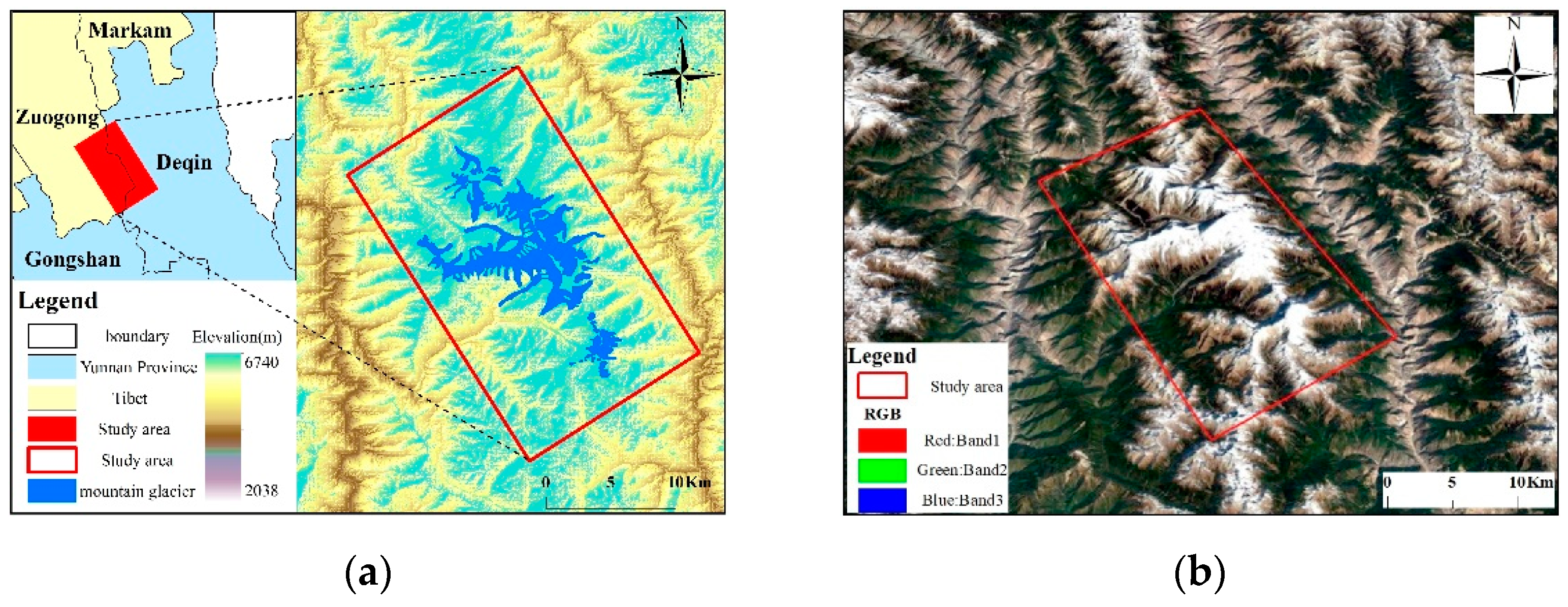




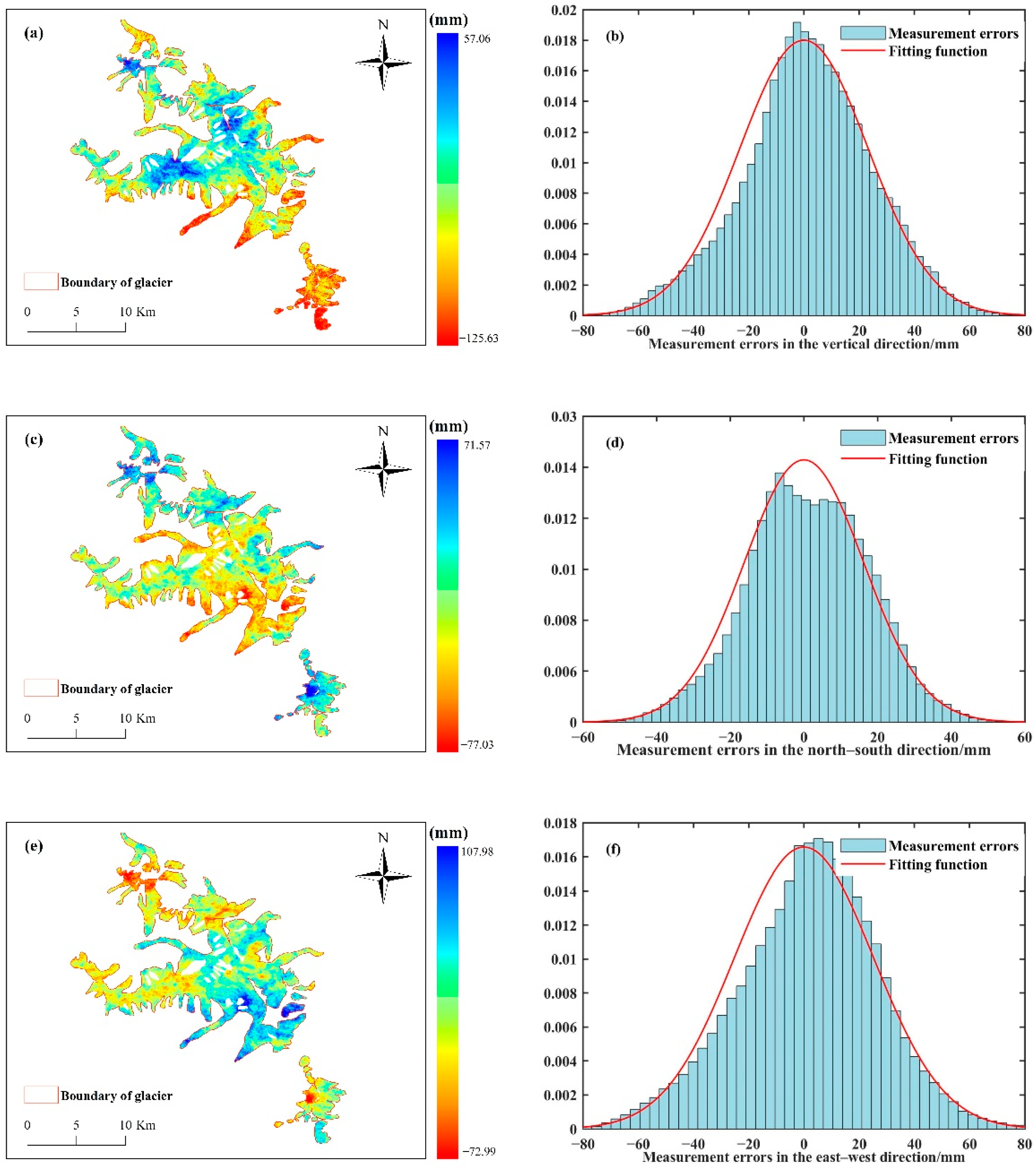
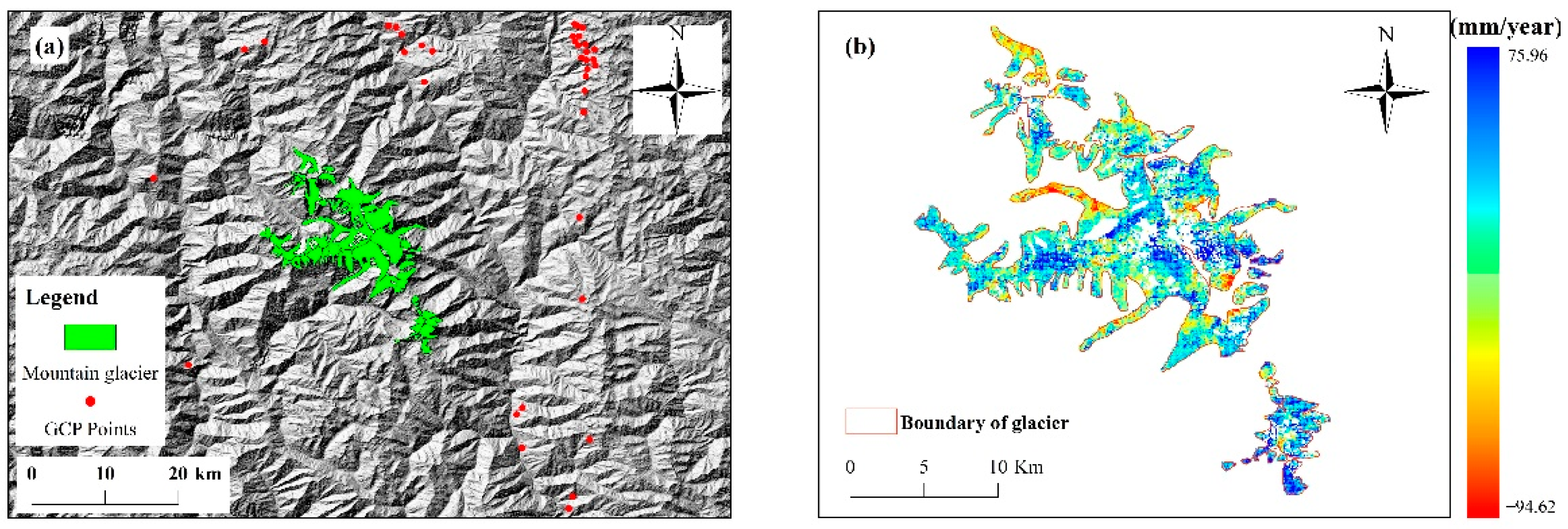
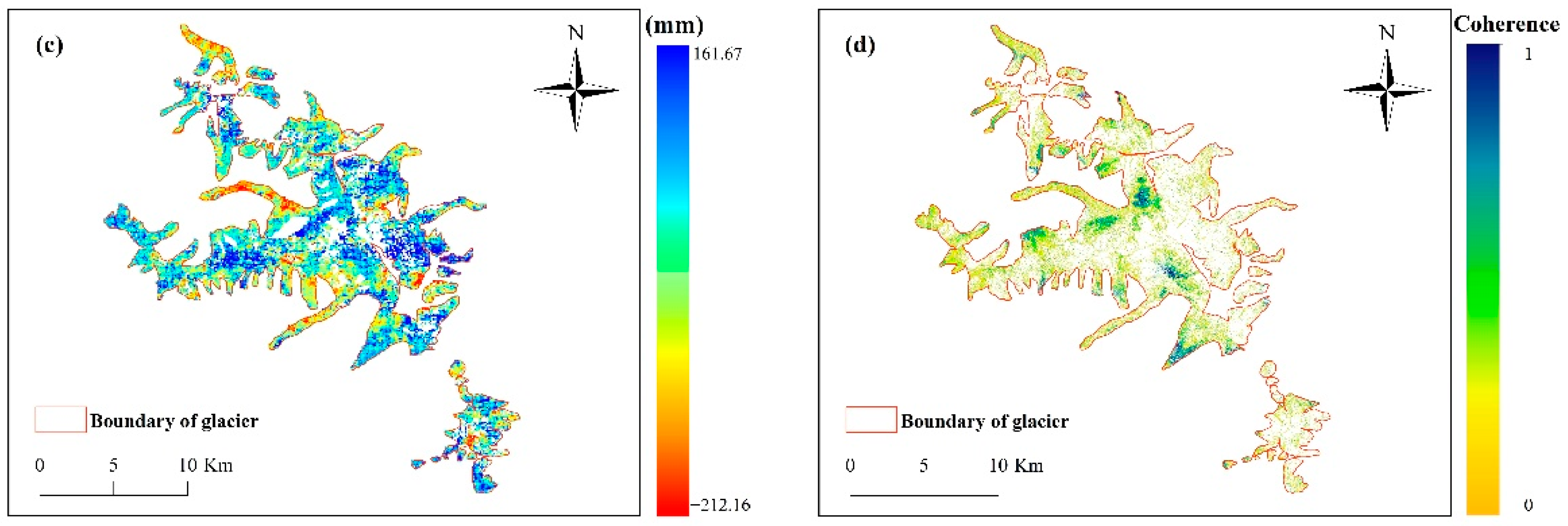
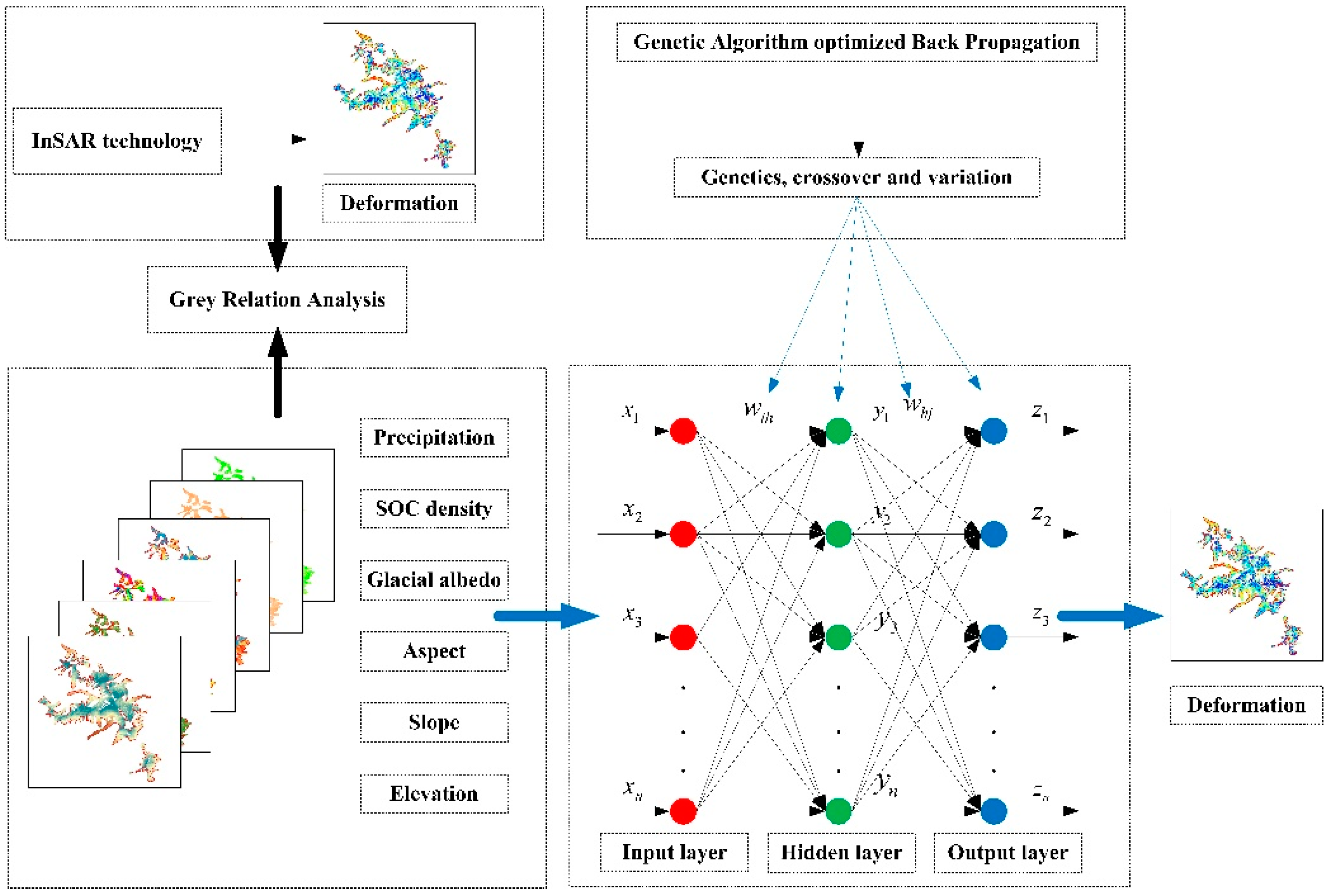
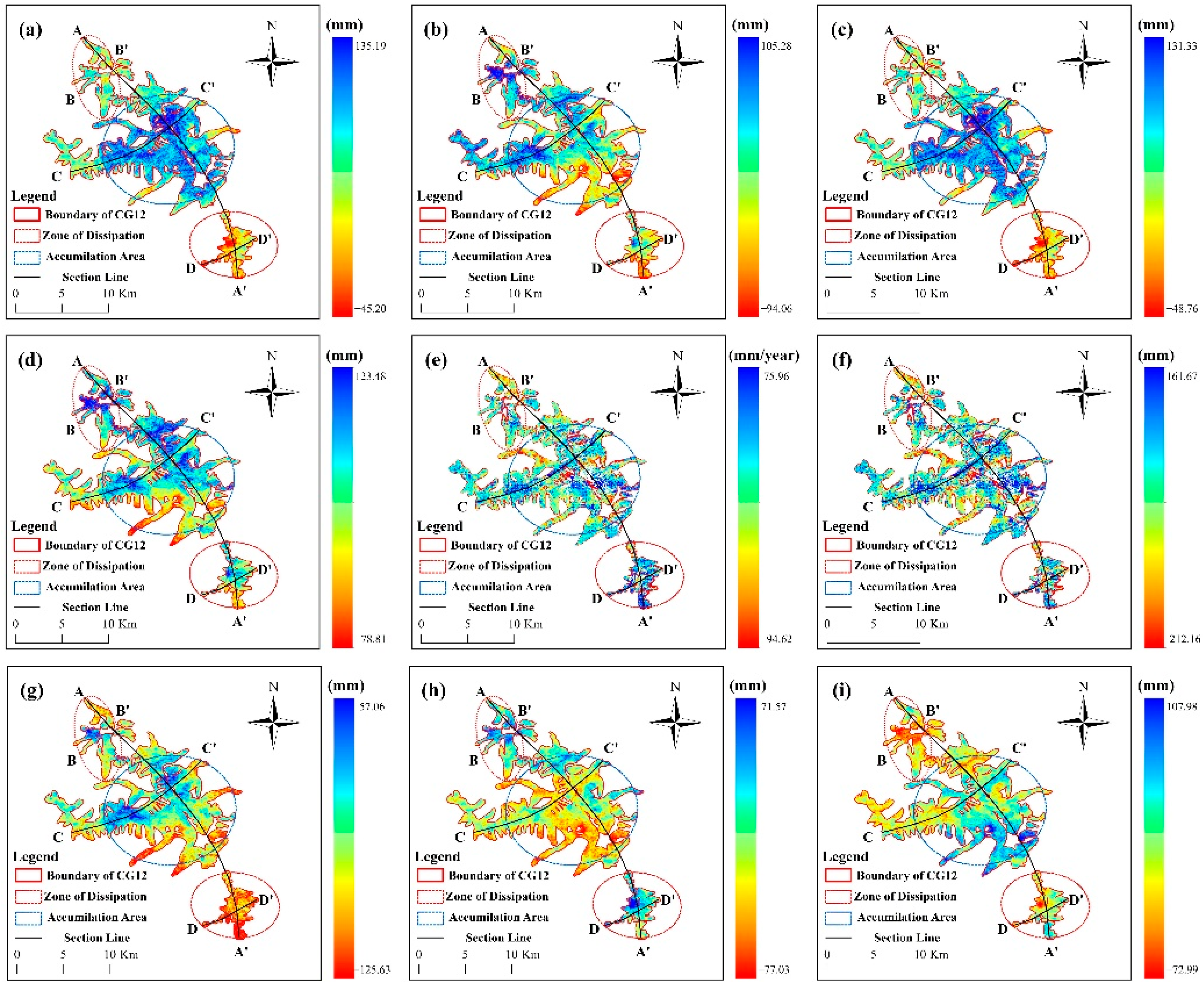
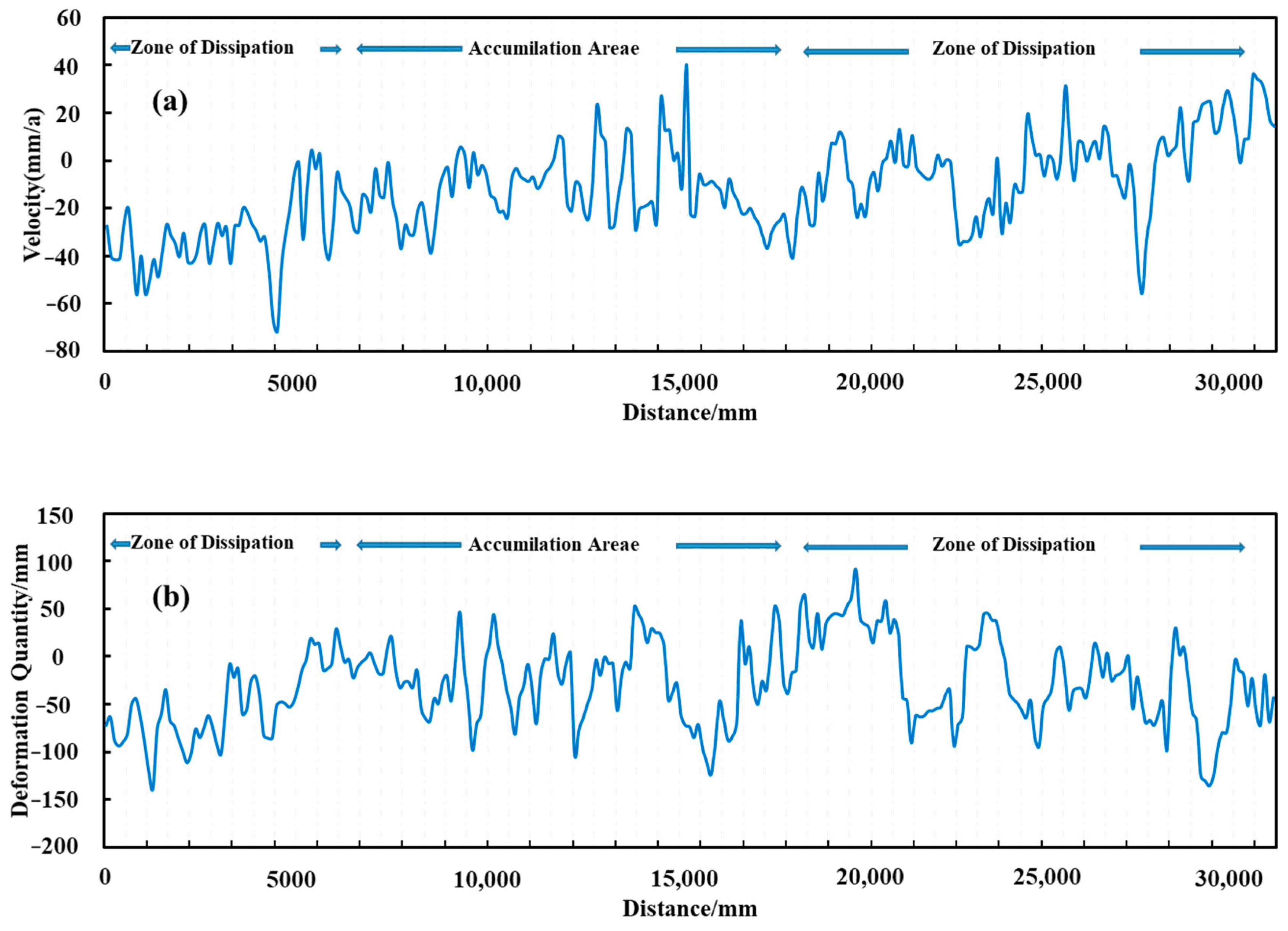
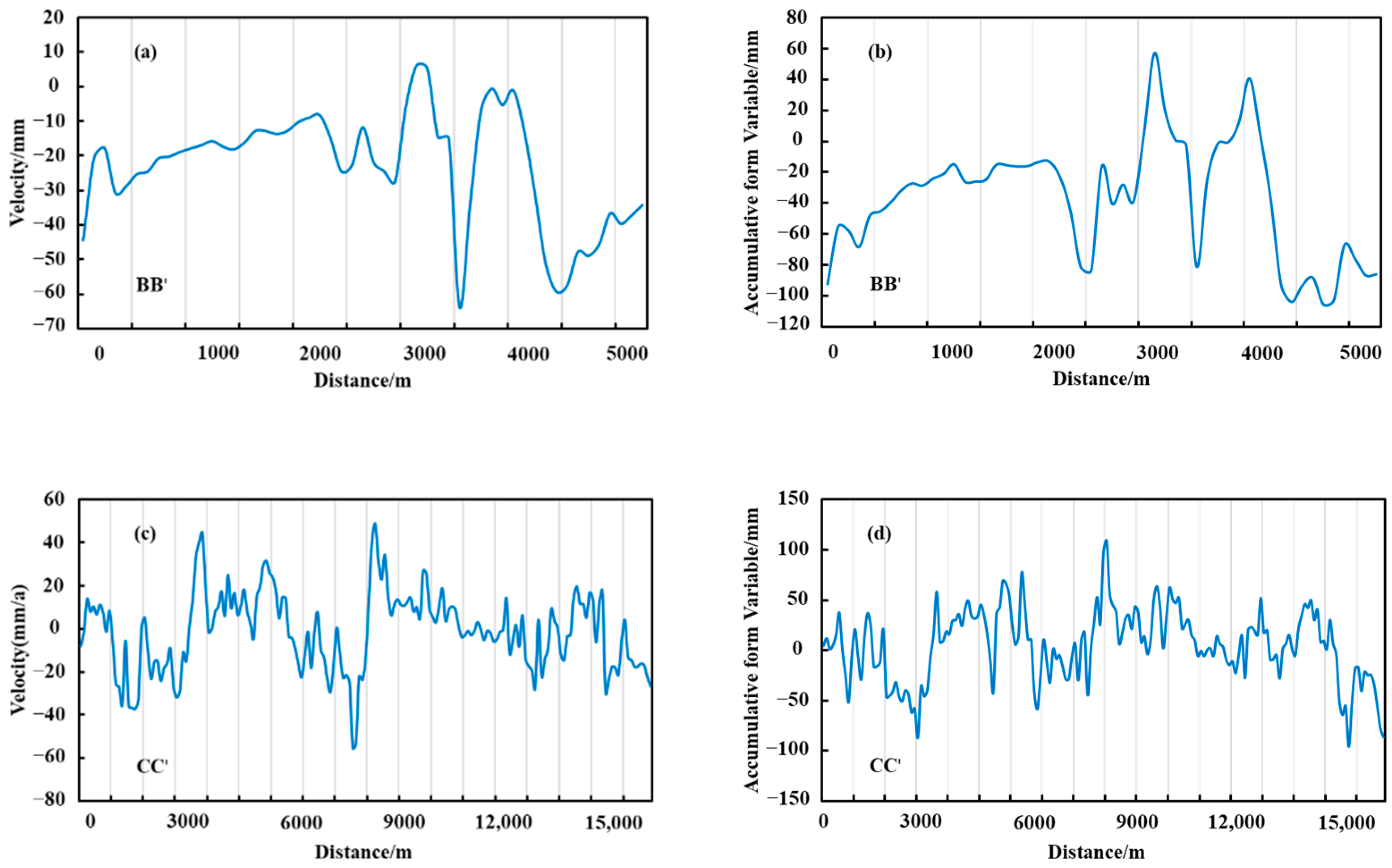

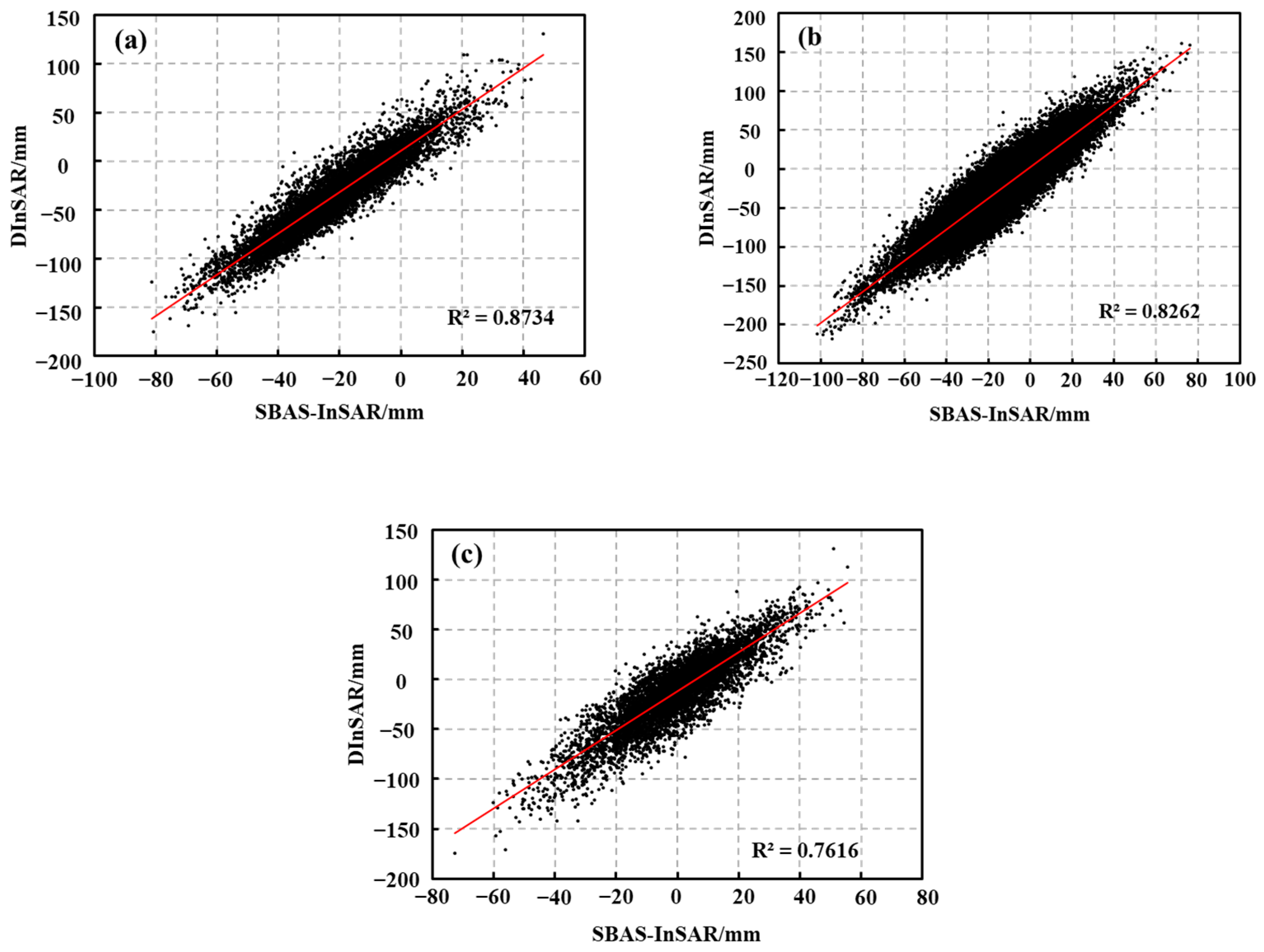
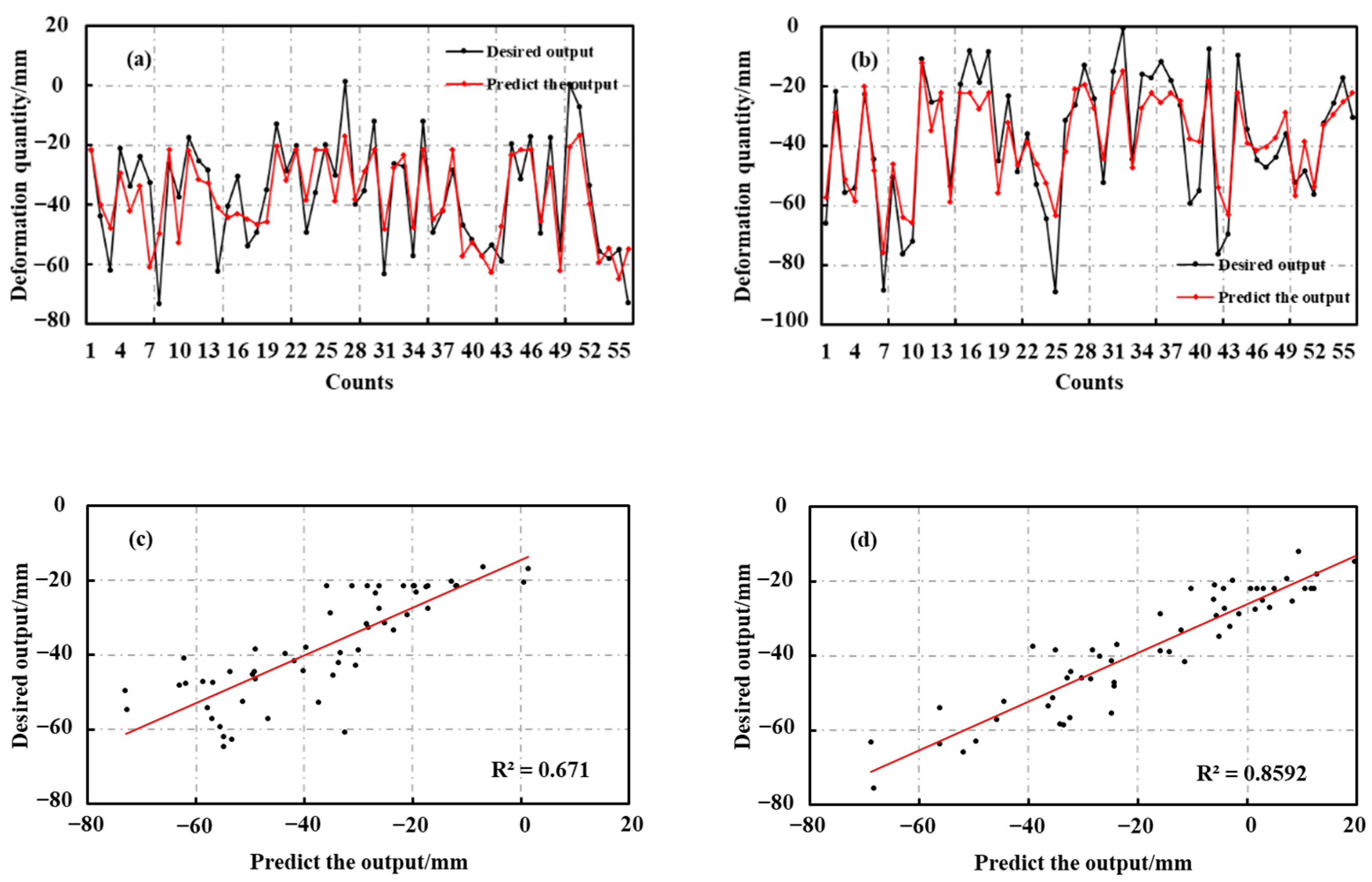

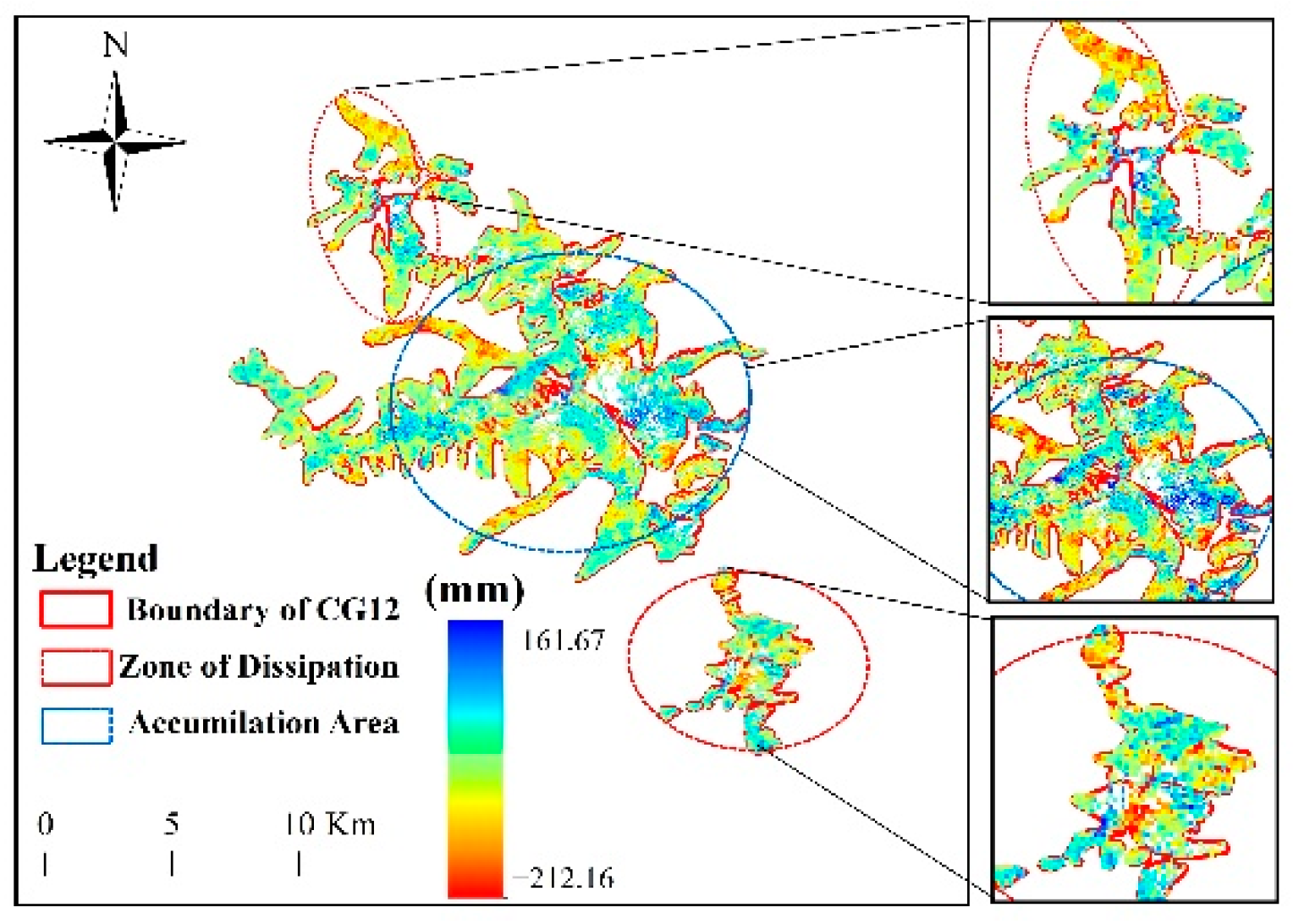
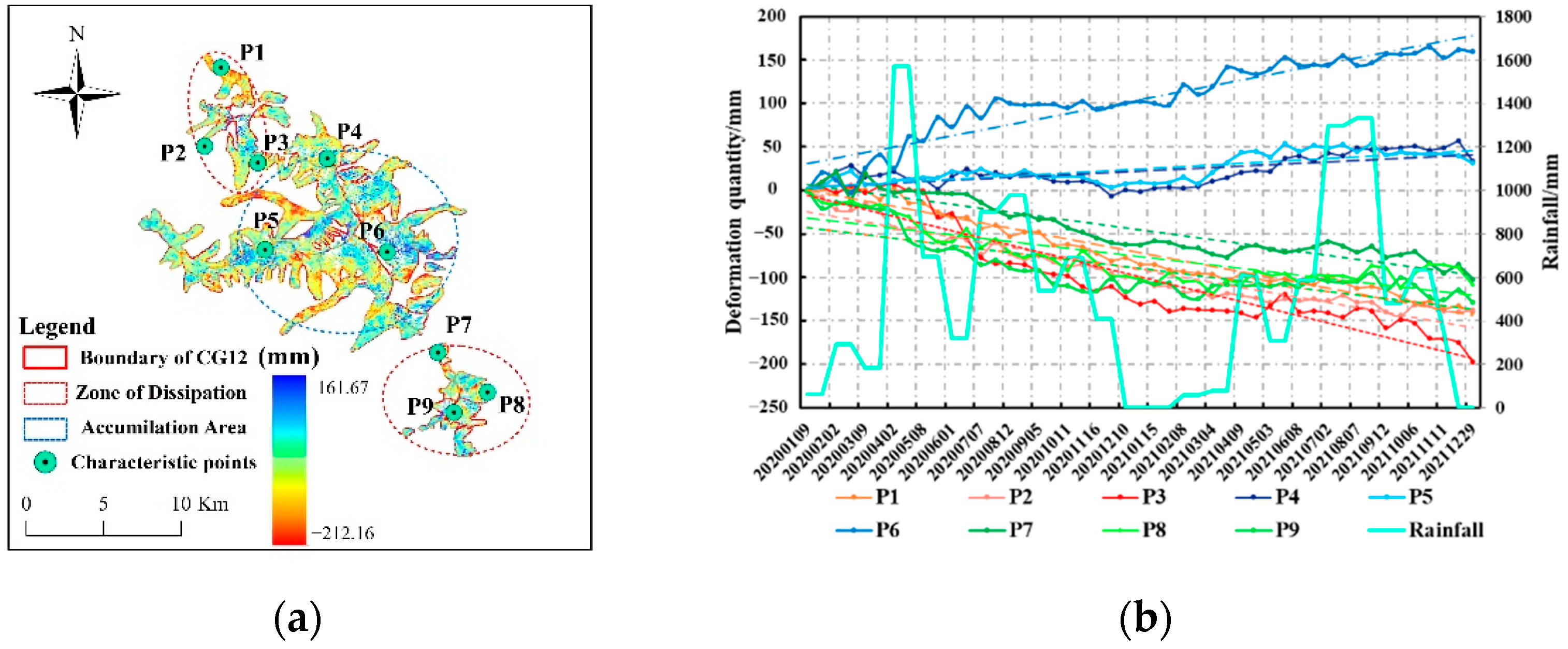
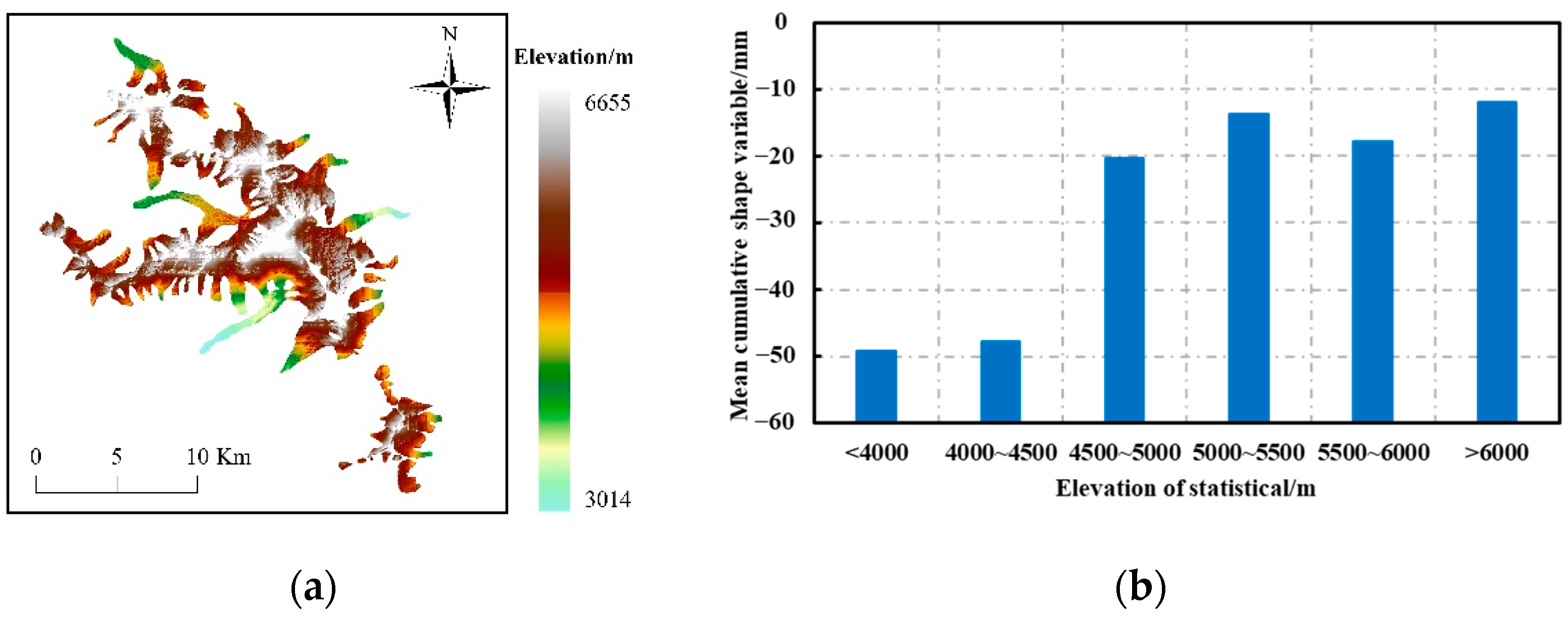
| Data Name | Data Phase | Data Type | Data Scale | Data Source |
|---|---|---|---|---|
| Sentinel-1 radar image | 2020-01–2021-12 | Raster | 5 m × 20 m | ESA |
| ALOS DEM | - | Raster | 30 m | JAXA |
| Elevation | - | Raster | 30 m | JAXA |
| Slope | - | Raster | 30 m | JAXA |
| Aspect | - | Raster | 30 m | JAXA |
| Glacial albedo | 2020-01–2021-12 | Raster | 30 m | Landsat 8 |
| SOC density | 2018 | Raster | 250 m | FAO |
| Precipitation | 2020-01–2021-12 | - | - | PPS |
| Google Maps imagery | 2021 | Raster | 0.2 m | Google Earth |
| Northern Melting Zone | Middle Accumulation Region | Southern Melting Zone | |
|---|---|---|---|
| Elevation | 0.935 | 0.970 | 0.946 |
| Slope | 0.938 | 0.979 | 0.954 |
| Aspect | 0.900 | 0.952 | 0.947 |
| Glacial albedo | 0.973 | 0.991 | 0.980 |
| SOC density | 0.936 | 0.988 | 0.963 |
| Precipitation | 0.755 | 0.844 | 0.811 |
| Network Functions for Each Layer | Setting Functions | Name of the Parameter | Setting Values |
|---|---|---|---|
| Activation function for the hidden layer | tandig | Training times | 10,000 |
| Learning rate | 0.01 | ||
| Activation function of the input layer | purelin | Evolutionary algebra | 40 |
| Population size | 20 | ||
| Training function | trainlm | Crossover probabilities | 0.2 |
| Probability of variation | 0.1 |
| BP | GA-BP | |
|---|---|---|
| R2 | 0.67 | 0.86 |
| Number of iterations | 105 | 30 |
| RMSE | 10.38 | 9.58 |
| MAPE | 1.17% | 1.12% |
Publisher’s Note: MDPI stays neutral with regard to jurisdictional claims in published maps and institutional affiliations. |
© 2022 by the authors. Licensee MDPI, Basel, Switzerland. This article is an open access article distributed under the terms and conditions of the Creative Commons Attribution (CC BY) license (https://creativecommons.org/licenses/by/4.0/).
Share and Cite
Yang, Z.; Xi, W.; Yang, Z.; Shi, Z.; Qian, T. Monitoring and Prediction of Glacier Deformation in the Meili Snow Mountain Based on InSAR Technology and GA-BP Neural Network Algorithm. Sensors 2022, 22, 8350. https://doi.org/10.3390/s22218350
Yang Z, Xi W, Yang Z, Shi Z, Qian T. Monitoring and Prediction of Glacier Deformation in the Meili Snow Mountain Based on InSAR Technology and GA-BP Neural Network Algorithm. Sensors. 2022; 22(21):8350. https://doi.org/10.3390/s22218350
Chicago/Turabian StyleYang, Zhengrong, Wenfei Xi, Zhiquan Yang, Zhengtao Shi, and Tanghui Qian. 2022. "Monitoring and Prediction of Glacier Deformation in the Meili Snow Mountain Based on InSAR Technology and GA-BP Neural Network Algorithm" Sensors 22, no. 21: 8350. https://doi.org/10.3390/s22218350
APA StyleYang, Z., Xi, W., Yang, Z., Shi, Z., & Qian, T. (2022). Monitoring and Prediction of Glacier Deformation in the Meili Snow Mountain Based on InSAR Technology and GA-BP Neural Network Algorithm. Sensors, 22(21), 8350. https://doi.org/10.3390/s22218350





